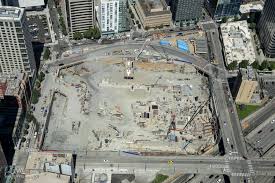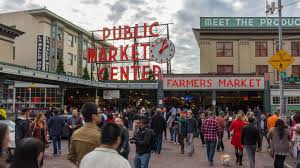By Mike McGinn and Joe Cortright
Editor’s Note: We’re pleased to publish this commentary jointly authored by former Seattle Mayor Mike McGinn and City Observatory’s Joe Cortright. Mike McGinn served as Mayor of Seattle from 2010 to 2013. He is also a former lawyer, Sierra Club state chair, neighborhood activist, and founder of sustainability non-profit Great City. You can follow him on Twitter @mayormcginn.
Seattle’s epic $1.8 billion convention center black hole reveals what’s wrong with city subsidies for conventions
Room taxes seldom get the scrutiny they deserve and have been captured by the convention industry to subsidize a narrow and declining segment of the tourism industry
A city’s real tourism assets are its urbanity and quality of life, not lifeless and interchangeable meeting rooms
The economics of the convention business have always been shaky, but in the wake of the pandemic, they’ve simply imploded. According to STR, an industry analytics firm, occupancy is down 50 percent and revenue per room is down by 70 percent compared to a year ago. Of course, this is a tough economic time for everyone, but unlike a lot of other sectors of the economy, this is one where local governments around the country have been conned into putting the public’s resources and credit on the line. And in this case, the decline in conventions is likely to hurt local governments.
Today’s object lesson in convention business risk comes from Seattle, where the local convention agency is in the midst of a $1.8 billion expansion of the Washington State Convention Center (WSCC). “Midst” is a good way of describing the project–they’ve broken ground and started construction, but even so, haven’t pulled together all the needed funding. The WSCC was essentially betting on its ability to sell bonds (themselves to be secured by future increases in room tax revenue) at just exactly the time that the Covid Recession came crashing down.

It’s a bit like signing a contract to build a home before the banker has given you a mortgage or jumping in a cab with no wallet and hoping your roommate is at home when you arrive. How could that happen. Well, in Seattle, like a lot of cities, the decision to move ahead with the project isn’t made directly by any elected, general purpose unit of government, but is instead governed by “public facilities district” which is a special purpose entity, whose only job is running the convention center.
The decision-making and financing on the convention center expansion project (remember: price tag: $1.8 billion), stands in stark contrast to other fiscal debates in Seattle in recent memory. In 2018 the city adopted—and then under pressure from local businesses repealed—a $50 million per year business tax that would have funded homeless housing and services. That proposal had to run a gauntlet of public process, and was stillborn precisely because it put elected city council members on a political hot seat.
Meanwhile, the plans to expand the convention center, which will be paid for by taxes, essentially escaped that kind of public scrutiny, both because the public facilities district isn’t an elected political body, and because it neatly decided to launch project construction before securing all the financing.
The Covid pandemic has blown a hole in the PFD’s finances: In a disclosure to bond holders on May 15, the district estimated its Apri-December revenues would decline by 60 to 75 percent, costing it between $49 and 70 million in just this year.
It would be tempting–as the convention center and tourism boosters–no doubt want to do, to blame this all on the Coronavirus pandemic, and the agency is angling for a tranche of federal bailout money as Congress contemplates further trillions in outlays. Consider that they are asking the Washington state congressional delegation to spend political capital to bail out a failed megaproject, while front-line hospitals lay off workers, and millions are a rent check away from homelessness. And if that fails, their next stop is probably state, county or city budgets, all deeply cratered by falling revenues.
It would be one thing if the convention center was a good investment felled by a poorly executed deal and bad timing. But that’s not the case. Convention Centers are a stagnant and dying industry that require endless taxes—the pandemic exposed its fragility.
Tourism boosters maintain that the convention center is vital to Seattle’s economy, noting all the people who stay at hotels and spend money in downtown Seattle. While it is true the visitor spending has stimulated the local economy, very little of that has anything to do with the convention center.
The problem is that the convention business has been struggling for more than a decade. In the wake of the Great Recession, convention business nationally never fully recovered. University of Texas San Antonio Professor Heywood Sanders, author of a definitive book on the industry, reports that the situation is now going from bad to much worse
The convention business has been on the decline for years, even as convention centers continue to expand to compete for a dwindling number of events — and it’s expected to take years to recover from the current bans on large in-person public gatherings, especially if organizers start experimenting with online meetings in the interim.
In Seattle, according to Sanders’ estimates–drawn from the convention center’s own data–the market has been just as weak for the past decade.
From 182,000 out of state attendees in 2007, the center’s business dropped to 85,450 in 2010. The first time it got back to the 2007 level was in 2018.
The outlook going forward is even worse. In the short run, Stay-at-Home orders have wiped out convention bookings into the summer, and will likely chill business for a good time longer. The very last public gatherings that are likely to be revived as we re-open are large events like conventions that bring hundreds or thousands of people, many by air, from around the country to spend days in crowded surroundings.
There are good reasons to believe that the widespread adoption of teleconferencing, like Zoom, will also put a permanent dent in business travel. Now that firms and their customers have become much more accustomed and adept to using electronic communication, the volume of business travel may come back much more slowly than it left. That matters for the convention center, not so much because perhaps of direct bookings (although many organizations are doing large scale webinars in place of meetings), but also because business travel is the cash cow that generates the room taxes that underwrite the convention center.
While boosters like to claim that the convention center is critical for the local visitor economy; its actually the case that the reverse is true: the convention center depends on room taxes—which are assessed on all overnight visitors, not just those attending conventions. According to data compiled by Sanders, convention visitors accounted for just 7 percent (350,000 of 4.8 million) of Seattle room nights in 2018. And because the room tax is an “ad valorem” tax—based on the amount spent, high spending business travelers are much more lucrative not just for hotels, but also for the public facilities district, which gets the room revenue.
Tourism boosters like to trade on the belief that room taxes are unlike any other tax revenue, and that they’re uniquely entitled to use them to subsidize selected parts of the travel business.
That will be put to the test when taxpayers are asked to bail out the convention center. Room taxes are taxes on economic activity, just like sales taxes–and earmarking them for big projects like this comes at the expense of every other tax-funded activity in the city. In effect, all Seattle is doing is taxing the much larger, and more lucrative stream of business and personal travel to the city to subsidize one shrinking and money-losing business (conventions and trade shows).

If Seattle–or any city–wants to capitalize on the tourism business, it’s not going to succeed by throwing money at the ever larger non-descript barns that are convention centers. One windowless basement conference room or banquet hall is indistinguishable from every other. The city’s real asset is its unique urban quality, its public spaces, art, culture, nightlife and its distinctive small businesses, like the restaurants, boutiques and vendors that dot downtown Seattle and Pike Place Market. In the wake of a pandemic recession, the City should be paying vastly more attention to these assets than the stranded asset and money pit that is the expansion of the Washington State Convention Center.
